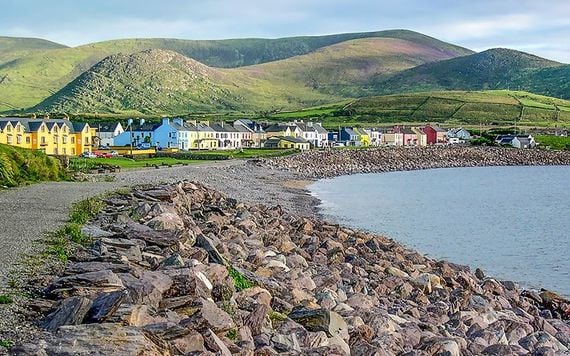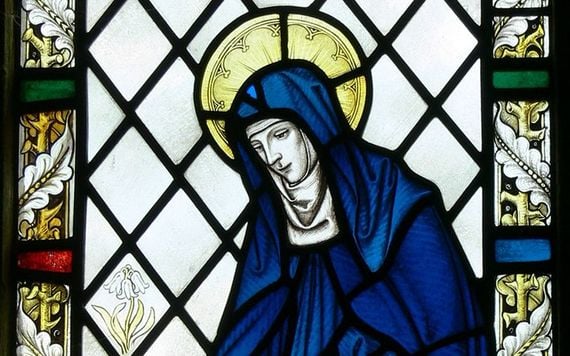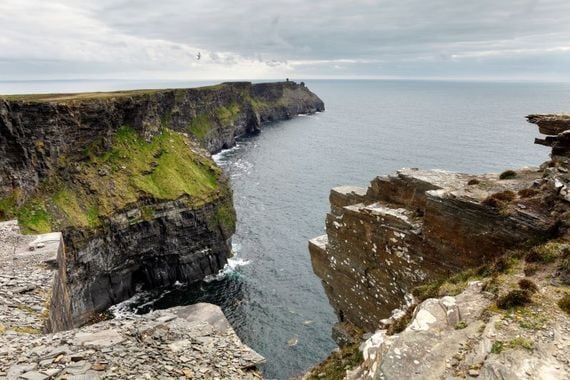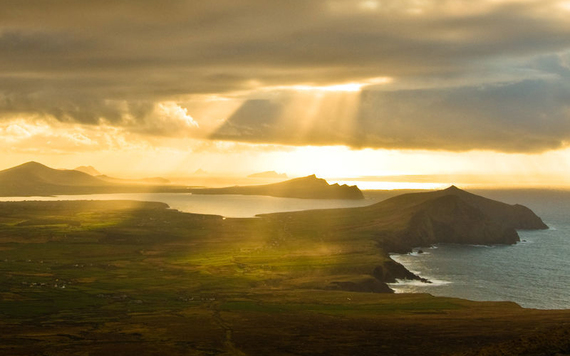The legends of the winter goddess and the locations and ancient Irish folklore, including Saint Brigid, the goddess of summer, are linked to her.
The Cailleach, or the hag, has been feared and revered across Celtic cultures in Ireland, Scotland and the Isle of Man, for hundreds of years. She is called Beira in Scotland and has strong associations with the Beara Peninsula in Ireland, which straddles County Cork and County Kerry.
Depicted as a veiled hag or an old crone, with one eye and deathly pale skin, she is said to have a bow-legged leaping gait, striding across mountains with a power to shape and transform the landscapes as rocks fall from her gathered apron.
The Cailleach is the goddess of the winter months and is said to control the weather and the winds as well as the length and harshness of winter. Her season begins on October 31st, the Samhain festival, which we celebrate today as Halloween.
She was a complex character, neither fully good nor evil, caring for animals during the dark winter months and was the patron of wolves. She is also known to safeguard deer and has particular affinities for black cats, wild cattle and goats.
Every woman
The word Cailleach comes from the "caillech" meaning "veiled one" in Gaelic. This word is the base root of many other words to describe women, such as the contemporary Irish word "cailin" meaning "girl".
Some scholars believe "cailleach" was more like a title, as the name has been associated with various figures throughout history and mythology: Digde, Milucra, Biróg (the fairy-woman who saved Lugh of the Long-Arm as an infant), Buí (one of Lugh’s wives), and Burach. All the tales of Celtic mythology were passed down through oral tradition for so long that it is difficult to untangle the web of stories and names given to the characters, and there are many versions of the Cailleach across the different territories.

Beara Peninsula.
She is sometimes called cailleach feasa ("wise woman, fortune-teller") and cailleach phiseogach ("sorceress, charm-worker”) but she is best-known as Cailleach Bhéara. An Cailleach lived (and rumour has it, lives still!) in the Beara Peninsula in the south of Ireland. She was said to be a shapeshifter, and could transform into a giant bird - "cailleach-oidhche", "the night hag", is old Gaelic for "owl".
Legends of the Cailleach
There is a tale of a wandering friar and his scribe who came to the old woman’s house. He inquired as to her great age, which he had heard stories of. She replied that she didn’t know, but that every year she killed an ox and made soup from the bones—and perhaps they could gauge her age by the number of ox bones thrown up in the attic. The young scribe climbed the ladder and threw the bones down one by one for the friar to count. The friar duly made a mark on his paper for each bone, and a great pile of bones grew until he had run out of paper. He called up to the young scribe, who replied that he had not even cleared one corner of the pile of bones, such was the great age of the Cailleach.
Another legend has it that Fintan the Wise of the hundred lives accompanied Noah's granddaughter, Cessair, to Ireland before the great Biblical flood. He thought himself the first to set foot on the island but found Cailleach living there, and could see she was far more ancient than himself. He is said to have asked of her, “Are you the one, the grandmother who ate the apples in the beginning?” but received no answer.
Yet another tale, linking her to deer, tells of the Cailleach appearing to two huntsmen and pointing them towards the best hunting ground. They felled an enormous stag and with great
effort dragged it home to their father’s house, but when they reached the cottage, the stag had disappeared, and the old man scolded them for not having blessed the meat as the Cailleach had instructed them, allowing the fairies to steal it.
In Irish mythology she had seven maidenhoods, bearing children by many husbands, before becoming eternally aged, outliving all her husbands and children. She is said to be the maternal ancestor of every Irish tribe.
Traditions and folklore
On Imbolc, February 1st, legend has it that the Cailleach runs out of her store of winter firewood and goes to gather more. If the day is fine and dry, it means that she will be able to gather more firewood and prolong the harsh winter months, but if it rains, she will have no fuel and so will have to give way to spring. This tradition traveled across the Atlantic and fed into what is known in the United States as Groundhog Day.
February 1st is now known as St Brigid’s Day in Ireland, as many pagan or pre-Christian festivals kept their dates and have a Christian festival attached to them. Brigid or Bridget, is the female patron saint of Ireland, but in pre-Christian times, Brigid was the goddess who ruled over the summer months.

St Brigid.
On May 1st, the festival of Bealtaine, the Cailleach is said to hand over to Brigid and cast her staff under a holly or gorse bush and turn to stone. Countless standing stones are said to be sacred to her. The stone she transforms into is said to remain moist despite the warmth of the summer months because of the life force it contains.
She was also the goddess of grain, a vital resource to survive the winter and the last sheath of grain harvested would be dedicated to her, and used to begin the planting for the next season.
Another superstition was that the young woman who tied the last sheaf of the harvest would never be married but live alone like the Cailleach. Their fate could be averted by feeding the last sheaf to a sheep.
On the trail of the Hag
The Cailleach is associated with more locations across the Gaelic-speaking world than any other deity, across Scotland as well as Ireland. Her ability to form the landscape and mountains means that many prominent mountain landmarks are attributed to her. According to legend, she either dropped or threw stones from her apron as she passed through the land and these grew into rock formations or mountains.
Hag’s Head on the Cliffs of Moher, in County Clare
Hag's Head, Cliffs of Moher, County Clare.
Hag’s Head is the name given to the most southerly point of the Cliffs of Moher, in County Clare, where the cliffs form an unusual rock formation that resembles a woman's head looking out to sea.
Legend has it that an old hag or sea-witch, Mal of Malbay, fell in love with the Irish hero Cú Chulainn and chased her him across Ireland. Cú Chulainn escaped her by running across the sea stacks as if they were stepping stones but Mal lost her footing and was dashed against the treacherous cliffs.
The Hag’s Chair, County Meath
The Hag’s Chair, County Meath.
The top of the Hag’s Mountain (Sliabh na Caillí) , is covered with the remains of a large complex of chambered cairns, with carved stones that likely predate the monumental carved stones of the Boyne Valley. The legend of the Cailleach jumping from hill to hill dropping stones, is associated with this area, the fallen stones forming the cairns. She is said to have dropped stones on the first three peaks but fell to her death as she leaped to the fourth, and is said to be buried on the slopes of Patrickstown Hill. Visitors today can sit on the Hag`s Chair, and it is said that if you make a wish while sitting on this kerbstone the witch will grant it.
Oileán Baoi/Dursey Island
Oileán Baoi/Dursey Island.
The name Boí, or Buí, sometimes associated with the Cailleach, gave rise to the name Oileán Baoi, Dursey Island, which is located at the tip of the Beara Peninsula, which was said to be her home. Her legacy lives on in many local name places e.g. Dunboy (Dun Baoi), Ballaghboy and Boharbui. This locality also claims to be her resting place, and it is said that Cailleach Beara’s fossilised remains overlook Coulagh Bay, Eyeries, awaiting the return of her husband, sea god Manannan Mac Lir.
Coulagh Bay, Eyeries, County Cork
Coulagh Bay, Eyeries, County Cork.
A large rock situated at Coulagh Bay, close to Eyeries in County Cork, is believed to represent the Cailleach’s face which turned to stone as she stared out to sea, waiting in vain for her husband, Manannan Mac Lir, to return to her. Even today, people visiting the site often leave coins, trinkets and other offerings to appease the Cailleach.
Kilcatherine, County Cork
Kilcatherine, County Cork.
Another legend associated with Kilcatherine in County Cork also ends with the Cailleach turning to stone. An Cailleach considered the arrival of Saint Caithighearn (Catherine), who preached Christianity, as a threat to her powers. One day, the hag happened upon the saint sleeping and stole her prayer book. A cripple who lived nearby saw what occurred and shouted, waking Saint Caithighearn. The saint ran after her, and caught up with her in Ard na Caillí, recovering her prayer book and turning the hag to stone with her back to the hill and her face to the sea. The ruins of of Kilcatherine church and Graveyard are a short distance from the Hag of Beara rock.
The Hag’s Glen and the Dingle Peninsula
Dingle Peninsula.
The Book of Lecan (a medieval Irish manuscript written between 1397 and 1418, in Sligo) claims that the Cailleach Béara was the chief goddess of the Corcu Duibne people of Kerry, a tribe that settled on the Dingle Peninsula. The peninsula is nowadays known as Corca Dhuibhne in Irish. Nearby in the MacGilliycuddy’s Reeks mountain range is Hag’s Glen, a 4km long valley surrounded by a majestic mountain range containing the country’s highest peak, Carrauntoohill (1,040m). The local legend tells of three hags living in Kerry and after one died, a fight broke out over a hair comb shared between the remaining two. The hag of Hag of Corrán Tuathail (Carrauntoohill) plunged to her death in the lake known as Hag’s Lake, and her footprints and those of the infant she was nursing are said to be visibly imprinted in the rock known as Carraig na Lathí.
* Originally published in Ireland of the Welcomes magazine, updated in Nov 2025.




Comments